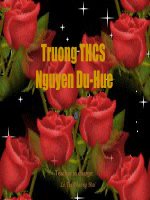- Trang chủ >>
- THPT Quốc Gia >>
- Ngữ Văn
Unit 2 CLOTHNG LESSON 1
Bạn đang xem bản rút gọn của tài liệu. Xem và tải ngay bản đầy đủ của tài liệu tại đây (105.53 KB, 3 trang )
<span class='text_page_counter'>(1)</span><div class='page_container' data-page=1>
UNIT 2: CLOTHING
<b>LESSON 1: GETTING STARTED AND LISTEN AND READ</b>
<b>Aims: to give the students some information about clothing in the world, especially the Ao Dai of </b>
Viet Nam.
<b>Objectives: By the end of the lesson the students will be able to know some traditional dresses of </b>
some countries in the world, the history and development of the Ao Dai of Viet Nam.
<b>Skills: Reading, Speaking, Writing</b>
<b>Teaching aids: Book, Pictures, Poster.</b>
Languages:
<b>Grammar: The simple past.</b>
<b>Vocabulary: mention, the traditional dress, consist of, design, material, line of poetry, </b>
inspiration, fashion designer, fashionable.
<b>TIME</b> <b>PROCEDURE</b> <b>T’S ACTIVITIES</b> <b>STS’</b>
<b>ACTIVITIES</b>
4’
<b>I.</b> <i><b>WARMER: Matching.</b></i>
Match the traditional clothing with the
countries where they are worn.
<b>A</b> <b>Match</b> <b>B</b>
1. Viet Nam
2. Japan
3. India
4. The USA
5. Arabia
6. Scotland
<b>1 – d</b>
<b>2 – c</b>
<b>3 – a</b>
<b>4 – f</b>
<b>5 – e</b>
<b>6 – b</b>
a. Sari
b. Vaùy Aboyne.
c. Kimono
d. Ao Dai
e. Bisht or Abaya
f. Jean
- Explains how to play
- Controls the activity. - Match column A to column B
15’
<b>II.</b> <i><b>PRE-READING:</b></i>
<b>1. Pre-teach vocabulary:</b>
- to mention /'men<sub></sub>n/ : đề cập
- the traditional dress /tr<sub></sub>'di<sub></sub>nl dres/: áo dài
truyền thống
- to consist of /k<sub></sub>n'sist <sub></sub>f/: gồm có, bao gồm
- the design /di'zain/: mẫu thiết kế
- material /m<sub></sub>'ti<sub></sub>ri<sub></sub>l/: chất liệu
- line of poetry /lain <sub></sub>f 'poutri/: dòng thơ
- inspiration /<sub></sub>insp<sub></sub>'rei<sub></sub>n/: nguồn cảm hứng
- a fashion designer /'f<sub></sub>n di'zain<sub></sub>/: nhà tạo mẫu
thời trang.
- fashionable /'f<sub></sub>n<sub></sub>bl/(adj): hợp thời trang
<b>Bingo:</b>
- Follows the steps for
presenting vocabulary.
- Listen and
observe what the
teacher does.
Period: 8
</div>
<span class='text_page_counter'>(2)</span><div class='page_container' data-page=2>
<b>2. Set the scene:</b>
We’re going to read a text about the history
and development of the Ao Dai.
<b>3. True or False prediction statements:</b>
a. Lots of people have mentioned the Ao Dai in
poems, novels and songs.
b. Traditionally, it was frequently only worn by
women.
c. The designs and materials used for men and
women were the same.
d. Now, most of Vietnamese women like wearing
<i>Ao Dai at work.</i>
e. To make the Ao Dai more fashionable, some
fashion designers printed line of poetry on it.
f. Some other designers added the symbols as
suns, stars, crosses, stripes to the Ao Dai.
a b c d e f
- Gives the common
idea of the lesson.
- Sticks the poster on
the board and run
through.
- Listen.
- Guess.
20’ <b>III.</b> <i><b>WHILE- READING:</b></i>
<b>1. Read to check the T/F:</b>
<b>Key:</b>
a b c d e f
<b>T F F F T T</b>
<b>2. Group-work :</b>
Read the text carefully and fill in the blanks
part a page14 with the suitable words or phrases.
<b>Key:</b>
a. poems – novels and songs
b. long silk tunic with slits up the sides worn over
loose pants
c. to wear modern clothing at work.
d. Lines of poetry on it.
e. Symbols such as suns, stars, crosses and
stripes.
<b>3. Multiple choice :</b>
<i>Read the text again and answer the questions:</i>
1. Who used to wear the Ao Dai by tradition?
a. <b>Both men and women used to wear the </b>
<i><b>Ao Dai by tradition.</b></i>
b. Men used to wear the Ao Dai by tradition.
c. Women used to wear the Ao Dai by
tradition
2. Why do the majority of Vietnamese
- Gives the students
time to read the
passages and check
the T/F prediction
statements.
- Asks the students to
read the passages
carefully again and fill
in the gaps with
suitable words or
phrases.
- Gives more time for
the students to read
the passages and
answer the questions.
- Read to check.
- Read the
passages again and
find out the
suitable words to
fill in the gaps.
</div>
<span class='text_page_counter'>(3)</span><div class='page_container' data-page=3>
women prefer to wear modern clothing at
work these days?
a. Because modern clothing is cheap.
<b>b. Because it is more convenient.</b>
c. Because modern clothing is beautiful.
3. What have fashion designers done to
modernize the Ao Dai?
<i><b>a.</b></i> Fashion designers printed lines of poetry
on the Ao Dai.
<i><b>b.</b></i> Fashion designers added symbols such as
suns, stars, crosses, stripes to the Ao Dai.
<i><b>c.</b></i> <b>a and b.</b>
<b>Key: 1 – a; 2 – b; 3 – c </b>
5’
<b>IV.</b> <i><b>POST- READING:</b></i>
<b>Discussion in group: Project</b>
a. What kinds of clothes do people wear when
they are at the office, home, school,
party……..?
b. Which kinds of clothes do you want to wear?
<i><b>Report to the class.</b></i>
- Gives students a
project.
- Explains how to do.
- Take notes.
- Work in groups
with partners.
1’
<b>V.</b> <i><b>HOMEWORK:</b></i>
- Learn the lesson carefully.
- Write the answers of the exercise into your
workbook.
- Prepare for the project carefully.
- Gives home
assignment. - Take notes.
<b>Notes :</b>
- Bisht: trang phục dành cho nam của người Arab
- Abaya: trang phục dành cho nữ của người Arab.
</div>
<!--links-->









